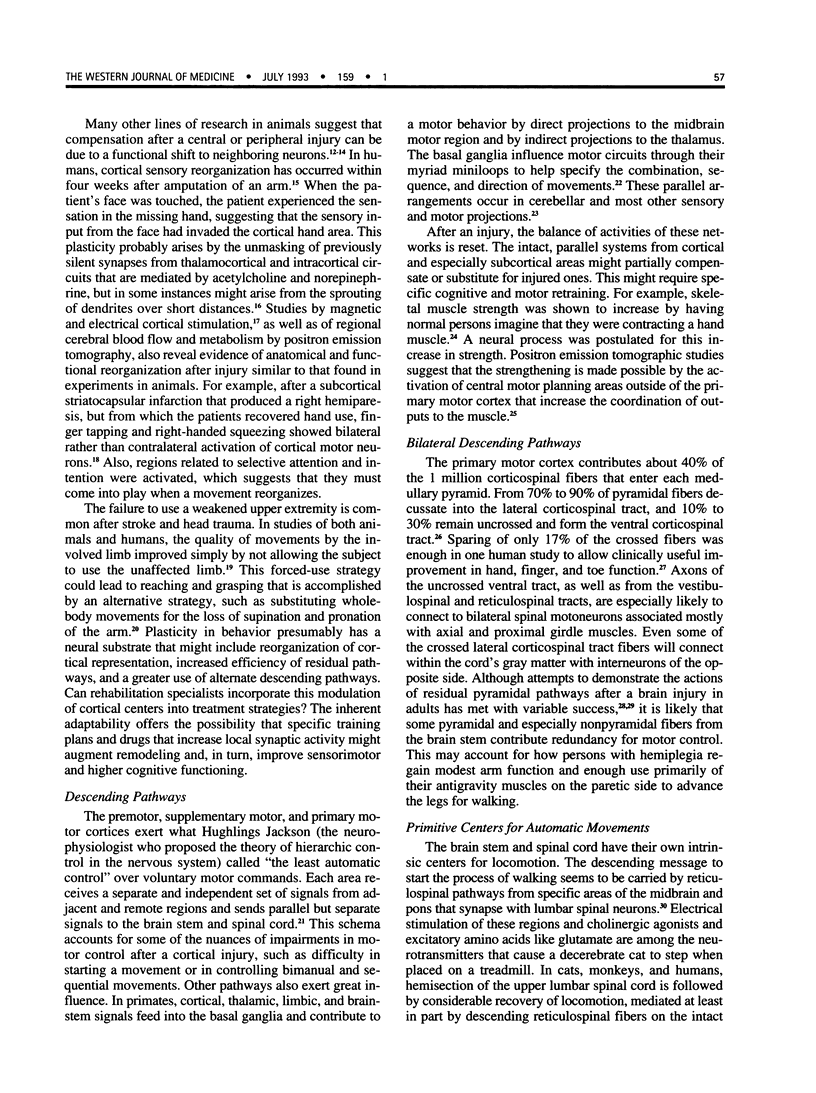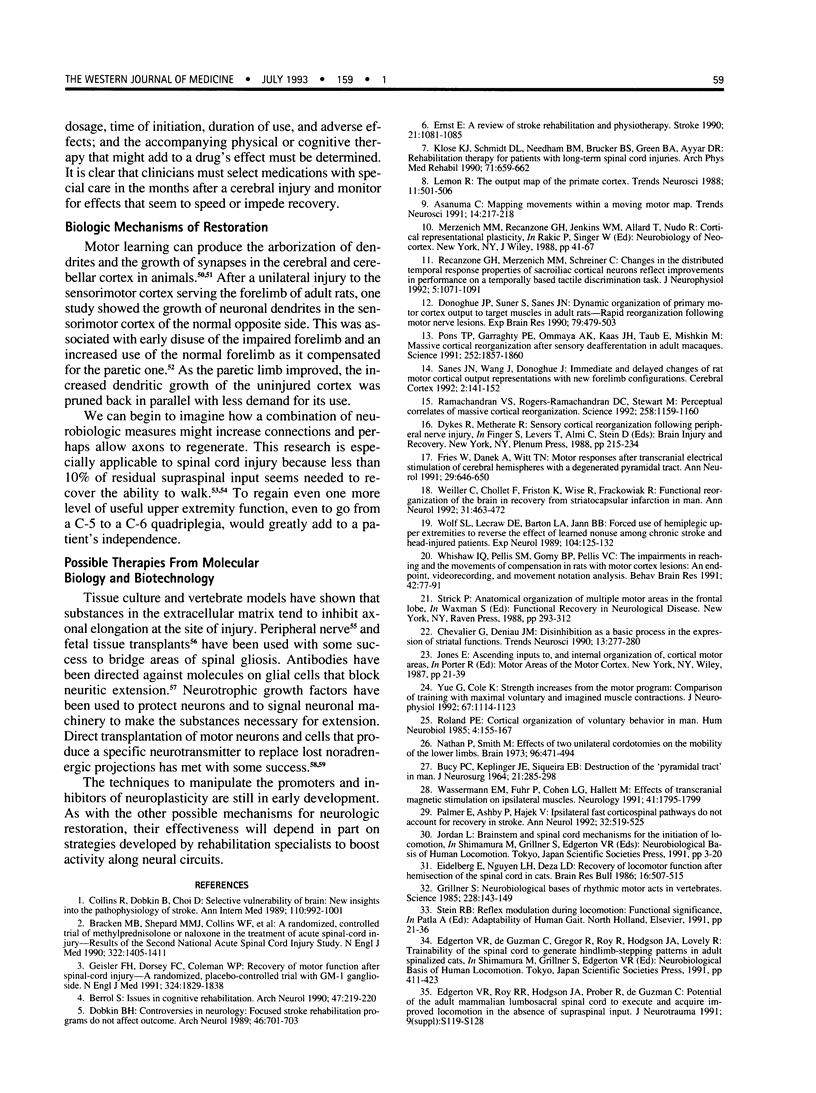Abstract
After an injury to the central nervous system, physical and cognitive impairments and disabilities often abate. These gains may be partly mediated by mechanisms that allow reorganizing of the structure and function within gray and white matter. The potential to enhance neurologic recovery by manipulating the brain and spinal cord must now be considered in clinical practice. Today's rehabilitation routines may not encourage maximum recovery. Indeed, some commonly used physical and pharmacologic methods could inhibit the restoration of motor activities such as walking. On the other hand, therapies that use our expanding knowledge of neuroplasticity could lead to better results for patients.
Full text
PDF




Selected References
These references are in PubMed. This may not be the complete list of references from this article.
- Aguayo A. J., Rasminsky M., Bray G. M., Carbonetto S., McKerracher L., Villegas-Pérez M. P., Vidal-Sanz M., Carter D. A. Degenerative and regenerative responses of injured neurons in the central nervous system of adult mammals. Philos Trans R Soc Lond B Biol Sci. 1991 Mar 29;331(1261):337–343. doi: 10.1098/rstb.1991.0025. [DOI] [PubMed] [Google Scholar]
- Asanuma C. Mapping movements within a moving motor map. Trends Neurosci. 1991 Jun;14(6):217–218. doi: 10.1016/0166-2236(91)90115-b. [DOI] [PubMed] [Google Scholar]
- BUCY P. C., KEPLINGER J. E., SIQUEIRA E. B. DESTRUCTION OF THE "PYRAMIDAL TRACT" IN MAN. J Neurosurg. 1964 May;21:285–298. [PubMed] [Google Scholar]
- Berrol S. Issues in cognitive rehabilitation. Arch Neurol. 1990 Feb;47(2):219–220. doi: 10.1001/archneur.1990.00530020127025. [DOI] [PubMed] [Google Scholar]
- Black J. E., Isaacs K. R., Anderson B. J., Alcantara A. A., Greenough W. T. Learning causes synaptogenesis, whereas motor activity causes angiogenesis, in cerebellar cortex of adult rats. Proc Natl Acad Sci U S A. 1990 Jul;87(14):5568–5572. doi: 10.1073/pnas.87.14.5568. [DOI] [PMC free article] [PubMed] [Google Scholar]
- Blight A. R. Cellular morphology of chronic spinal cord injury in the cat: analysis of myelinated axons by line-sampling. Neuroscience. 1983 Oct;10(2):521–543. doi: 10.1016/0306-4522(83)90150-1. [DOI] [PubMed] [Google Scholar]
- Bracken M. B., Shepard M. J., Collins W. F., Holford T. R., Young W., Baskin D. S., Eisenberg H. M., Flamm E., Leo-Summers L., Maroon J. A randomized, controlled trial of methylprednisolone or naloxone in the treatment of acute spinal-cord injury. Results of the Second National Acute Spinal Cord Injury Study. N Engl J Med. 1990 May 17;322(20):1405–1411. doi: 10.1056/NEJM199005173222001. [DOI] [PubMed] [Google Scholar]
- Chevalier G., Deniau J. M. Disinhibition as a basic process in the expression of striatal functions. Trends Neurosci. 1990 Jul;13(7):277–280. doi: 10.1016/0166-2236(90)90109-n. [DOI] [PubMed] [Google Scholar]
- Clowry G., Sieradzan K., Vrbová G. Transplants of embryonic motoneurones to adult spinal cord: survival and innervation abilities. Trends Neurosci. 1991 Aug;14(8):355–357. doi: 10.1016/0166-2236(91)90162-n. [DOI] [PubMed] [Google Scholar]
- Collins R. C., Dobkin B. H., Choi D. W. Selective vulnerability of the brain: new insights into the pathophysiology of stroke. Ann Intern Med. 1989 Jun 15;110(12):992–1000. doi: 10.7326/0003-4819-110-12-992. [DOI] [PubMed] [Google Scholar]
- Connor J. R., Diamond M. C. A comparison of dendritic spine number and type on pyramidal neurons of the visual cortex of old adult rats from social or isolated environments. J Comp Neurol. 1982 Sep 1;210(1):99–106. doi: 10.1002/cne.902100111. [DOI] [PubMed] [Google Scholar]
- Crisostomo E. A., Duncan P. W., Propst M., Dawson D. V., Davis J. N. Evidence that amphetamine with physical therapy promotes recovery of motor function in stroke patients. Ann Neurol. 1988 Jan;23(1):94–97. doi: 10.1002/ana.410230117. [DOI] [PubMed] [Google Scholar]
- Dobkin B. H. Focused stroke rehabilitation programs do not improve outcome. Arch Neurol. 1989 Jun;46(6):701–703. doi: 10.1001/archneur.1989.00520420123035. [DOI] [PubMed] [Google Scholar]
- Donoghue J. P., Suner S., Sanes J. N. Dynamic organization of primary motor cortex output to target muscles in adult rats. II. Rapid reorganization following motor nerve lesions. Exp Brain Res. 1990;79(3):492–503. doi: 10.1007/BF00229319. [DOI] [PubMed] [Google Scholar]
- Edgerton V. R., Roy R. R., Hodgson J. A., Prober R. J., de Guzman C. P., de Leon R. A physiological basis for the development of rehabilitative strategies for spinally injured patients. J Am Paraplegia Soc. 1991 Oct;14(4):150–157. doi: 10.1080/01952307.1991.11735848. [DOI] [PubMed] [Google Scholar]
- Eidelberg E., Nguyen L. H., Deza L. D. Recovery of locomotor function after hemisection of the spinal cord in cats. Brain Res Bull. 1986 Apr;16(4):507–515. doi: 10.1016/0361-9230(86)90180-2. [DOI] [PubMed] [Google Scholar]
- Ernst E. A review of stroke rehabilitation and physiotherapy. Stroke. 1990 Jul;21(7):1081–1085. doi: 10.1161/01.str.21.7.1081. [DOI] [PubMed] [Google Scholar]
- Fries W., Danek A., Witt T. N. Motor responses after transcranial electrical stimulation of cerebral hemispheres with a degenerated pyramidal tract. Ann Neurol. 1991 Jun;29(6):646–650. doi: 10.1002/ana.410290612. [DOI] [PubMed] [Google Scholar]
- Fung J., Stewart J. E., Barbeau H. The combined effects of clonidine and cyproheptadine with interactive training on the modulation of locomotion in spinal cord injured subjects. J Neurol Sci. 1990 Dec;100(1-2):85–93. doi: 10.1016/0022-510x(90)90017-h. [DOI] [PubMed] [Google Scholar]
- Geisler F. H., Dorsey F. C., Coleman W. P. Recovery of motor function after spinal-cord injury--a randomized, placebo-controlled trial with GM-1 ganglioside. N Engl J Med. 1991 Jun 27;324(26):1829–1838. doi: 10.1056/NEJM199106273242601. [DOI] [PubMed] [Google Scholar]
- Grillner S. Neurobiological bases of rhythmic motor acts in vertebrates. Science. 1985 Apr 12;228(4696):143–149. doi: 10.1126/science.3975635. [DOI] [PubMed] [Google Scholar]
- Jones E. G. Ascending inputs to, and internal organization of, cortical motor areas. Ciba Found Symp. 1987;132:21–39. doi: 10.1002/9780470513545.ch3. [DOI] [PubMed] [Google Scholar]
- Jones T. A., Schallert T. Overgrowth and pruning of dendrites in adult rats recovering from neocortical damage. Brain Res. 1992 May 22;581(1):156–160. doi: 10.1016/0006-8993(92)90356-e. [DOI] [PubMed] [Google Scholar]
- Klose K. J., Schmidt D. L., Needham B. M., Brucker B. S., Green B. A., Ayyar D. R. Rehabilitation therapy for patients with long-term spinal cord injuries. Arch Phys Med Rehabil. 1990 Aug;71(9):659–662. [PubMed] [Google Scholar]
- Lemon R. The output map of the primate motor cortex. Trends Neurosci. 1988 Nov;11(11):501–506. doi: 10.1016/0166-2236(88)90012-4. [DOI] [PubMed] [Google Scholar]
- Little J. W., Harris R. M., Lerner S. J. Immobilization impairs recovery after spinal cord injury. Arch Phys Med Rehabil. 1991 May;72(6):408–412. [PubMed] [Google Scholar]
- Nathan P. W., Smith M. C. Effects of two unilateral cordotomies on the motility of the lower limbs. Brain. 1973 Sep;96(3):471–494. doi: 10.1093/brain/96.3.471. [DOI] [PubMed] [Google Scholar]
- Palmer E., Ashby P., Hajek V. E. Ipsilateral fast corticospinal pathways do not account for recovery in stroke. Ann Neurol. 1992 Oct;32(4):519–525. doi: 10.1002/ana.410320407. [DOI] [PubMed] [Google Scholar]
- Pons T. P., Garraghty P. E., Ommaya A. K., Kaas J. H., Taub E., Mishkin M. Massive cortical reorganization after sensory deafferentation in adult macaques. Science. 1991 Jun 28;252(5014):1857–1860. doi: 10.1126/science.1843843. [DOI] [PubMed] [Google Scholar]
- Ramachandran V. S., Rogers-Ramachandran D., Stewart M. Perceptual correlates of massive cortical reorganization. Science. 1992 Nov 13;258(5085):1159–1160. doi: 10.1126/science.1439826. [DOI] [PubMed] [Google Scholar]
- Recanzone G. H., Merzenich M. M., Schreiner C. E. Changes in the distributed temporal response properties of SI cortical neurons reflect improvements in performance on a temporally based tactile discrimination task. J Neurophysiol. 1992 May;67(5):1071–1091. doi: 10.1152/jn.1992.67.5.1071. [DOI] [PubMed] [Google Scholar]
- Roland P. E. Cortical organization of voluntary behavior in man. Hum Neurobiol. 1985;4(3):155–167. [PubMed] [Google Scholar]
- Sanes J. N., Wang J., Donoghue J. P. Immediate and delayed changes of rat motor cortical output representation with new forelimb configurations. Cereb Cortex. 1992 Mar-Apr;2(2):141–152. doi: 10.1093/cercor/2.2.141. [DOI] [PubMed] [Google Scholar]
- Schnell L., Schwab M. E. Axonal regeneration in the rat spinal cord produced by an antibody against myelin-associated neurite growth inhibitors. Nature. 1990 Jan 18;343(6255):269–272. doi: 10.1038/343269a0. [DOI] [PubMed] [Google Scholar]
- Strick P. L. Anatomical organization of multiple motor areas in the frontal lobe: implications for recovery of function. Adv Neurol. 1988;47:293–312. [PubMed] [Google Scholar]
- Sutton R. L., Hovda D. A., Feeney D. M. Amphetamine accelerates recovery of locomotor function following bilateral frontal cortex ablation in cats. Behav Neurosci. 1989 Aug;103(4):837–841. doi: 10.1037//0735-7044.103.4.837. [DOI] [PubMed] [Google Scholar]
- Tessler A. Intraspinal transplants. Ann Neurol. 1991 Feb;29(2):115–123. doi: 10.1002/ana.410290202. [DOI] [PubMed] [Google Scholar]
- Visintin M., Barbeau H. The effects of body weight support on the locomotor pattern of spastic paretic patients. Can J Neurol Sci. 1989 Aug;16(3):315–325. doi: 10.1017/s0317167100029152. [DOI] [PubMed] [Google Scholar]
- Wassermann E. M., Fuhr P., Cohen L. G., Hallett M. Effects of transcranial magnetic stimulation on ipsilateral muscles. Neurology. 1991 Nov;41(11):1795–1799. doi: 10.1212/wnl.41.11.1795. [DOI] [PubMed] [Google Scholar]
- Waxman S. G. Biophysical mechanisms of impulse conduction in demyelinated axons. Adv Neurol. 1988;47:185–213. [PubMed] [Google Scholar]
- Weiller C., Chollet F., Friston K. J., Wise R. J., Frackowiak R. S. Functional reorganization of the brain in recovery from striatocapsular infarction in man. Ann Neurol. 1992 May;31(5):463–472. doi: 10.1002/ana.410310502. [DOI] [PubMed] [Google Scholar]
- Wernig A., Müller S. Laufband locomotion with body weight support improved walking in persons with severe spinal cord injuries. Paraplegia. 1992 Apr;30(4):229–238. doi: 10.1038/sc.1992.61. [DOI] [PubMed] [Google Scholar]
- Whishaw I. Q., Pellis S. M., Gorny B. P., Pellis V. C. The impairments in reaching and the movements of compensation in rats with motor cortex lesions: an endpoint, videorecording, and movement notation analysis. Behav Brain Res. 1991 Jan 31;42(1):77–91. doi: 10.1016/s0166-4328(05)80042-7. [DOI] [PubMed] [Google Scholar]
- Wolf S. L., Lecraw D. E., Barton L. A., Jann B. B. Forced use of hemiplegic upper extremities to reverse the effect of learned nonuse among chronic stroke and head-injured patients. Exp Neurol. 1989 May;104(2):125–132. doi: 10.1016/s0014-4886(89)80005-6. [DOI] [PubMed] [Google Scholar]
- Yakovleff A., Roby-Brami A., Guezard B., Mansour H., Bussel B., Privat A. Locomotion in rats transplanted with noradrenergic neurons. Brain Res Bull. 1989 Jan;22(1):115–121. doi: 10.1016/0361-9230(89)90135-4. [DOI] [PubMed] [Google Scholar]
- Yue G., Cole K. J. Strength increases from the motor program: comparison of training with maximal voluntary and imagined muscle contractions. J Neurophysiol. 1992 May;67(5):1114–1123. doi: 10.1152/jn.1992.67.5.1114. [DOI] [PubMed] [Google Scholar]


